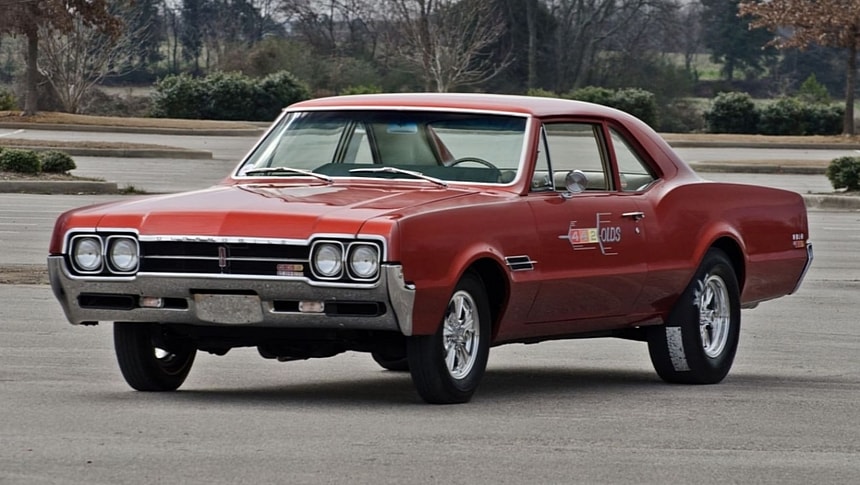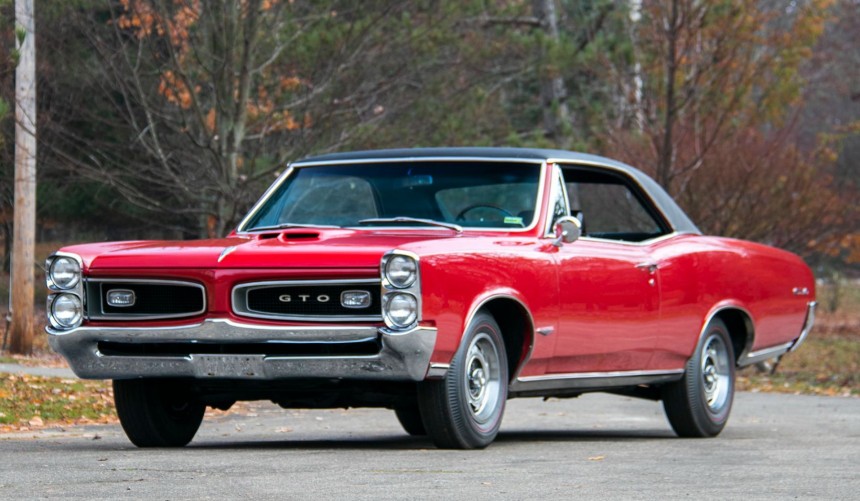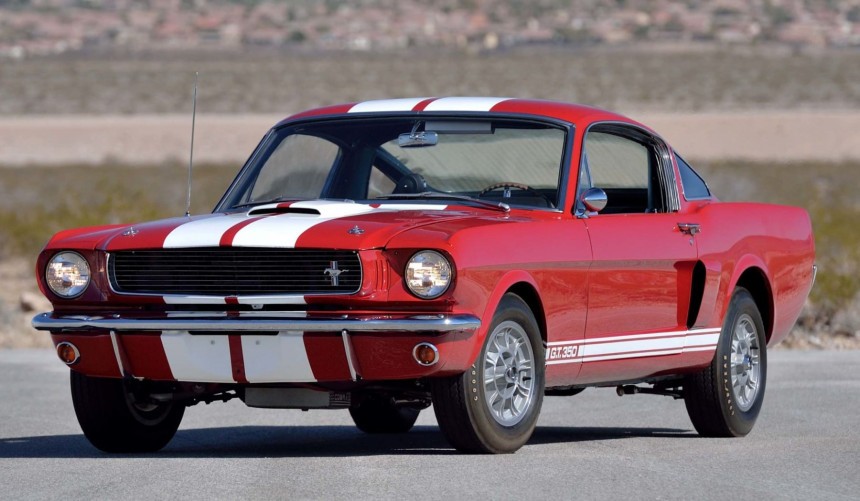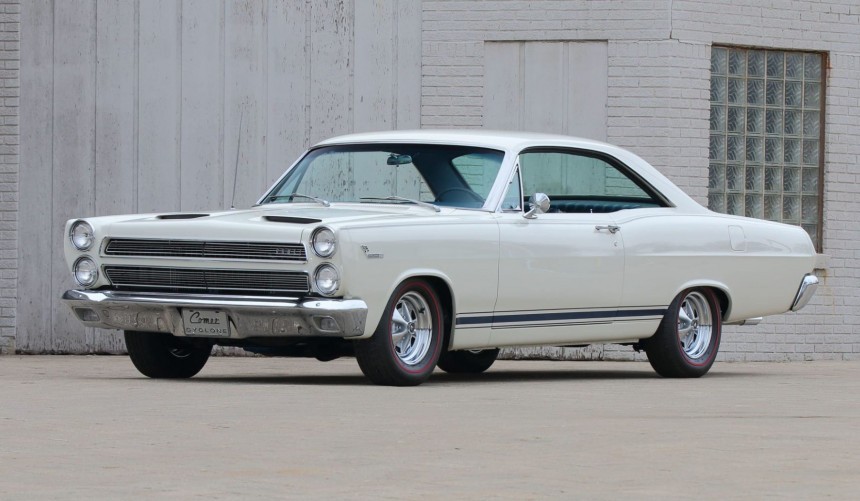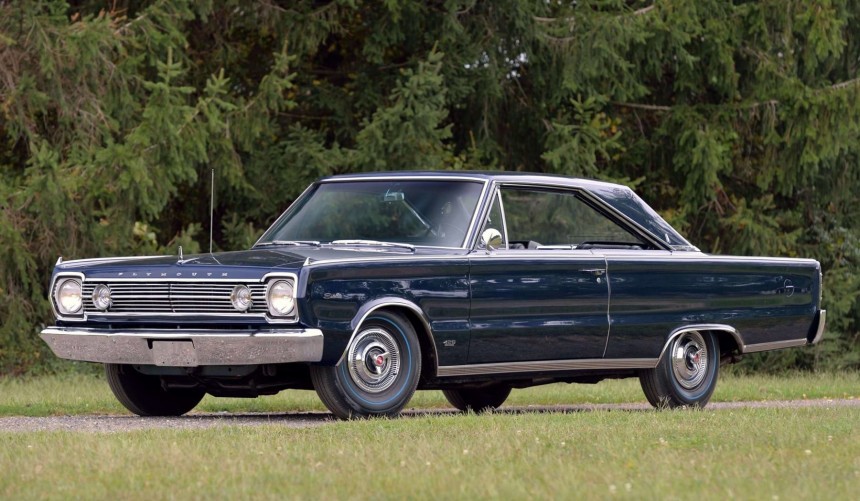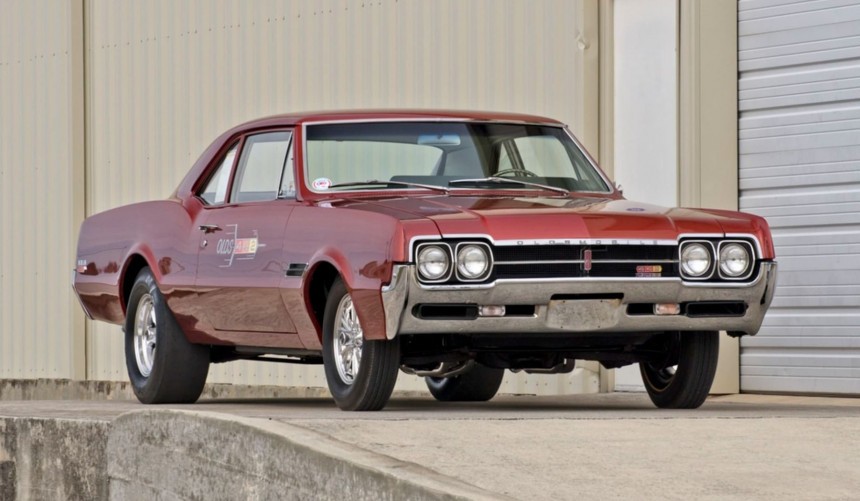In 1966, the American automotive industry was expanding its factory-built performance menu. While horsepower was often a deciding factor in terms of sales, quarter-mile times separated the winners from the losers in the hearts and minds of muscle car enthusiasts.
After a prolific 1965 model year that saw other manufacturers join the factory-built performance intermediate craze kicked off by Pontiac with its 1964 GTO, the battle for muscle car supremacy was heating up.
Pontiac, the rest of the GM divisions, as well as their crosstown rivals were stepping their performance game up, which lead to more power and faster cars.
Combining an intermediate platform with high-powered V8s, usually conceived for larger models, those thoroughbred muscle cars ensured their worth over the quarter mile.
Since the introduction of the LeMans-based performance heavyweight in 1964, the GTO was the undefeated champion of factory muscle.
For the 1966 model year, the GTO was no longer a performance package available on the LeMans but a separate model.
That said, the GTO was still based on the A-body platform, which was covered by either a two-door hardtop, pillarless coupe, or convertible body shared with the LeMans.
Changes from the previous year included a thorough restyling that made the car more curvaceous (particularly towards the rear), a new plastic grille (an industry first), and the addition of optional Strato bucket seats.
Under the hood, the GTO was available with the same 389-ci (6.4-liter) available in either single four-barrel or Tri-Power carburetor setups.
However, the now-legendary 360-hp Tri-Power, which was discontinued mid-model year, didn't receive any performance upgrades, so the GTO went from the quickest factory-built muscle car on the road in 1965 to the 5th quickest in 1966.
According to a test conducted by Car and Driver magazine, the Tri-Power GTO was still able to achieve a 14.5-second quarter-mile run, but this year, four rivaling models could go faster.
When it was first introduced in the spring of 1964, the Mustang became a marketing hit, but while powerful V8s became available, it fell short of reaching muscle car levels.
That started to change in 1965 when Carroll Shelby and his Venice crew took the Mustang, put it on a diet, and infused some muscle under its hood.
The resulting GT350, which was developed to dominate the SCCA (Sports Club of America) Group B Production series, was a Mustang turned bonafide tire-shredder that became the third quickest muscle car of 1965.
A year later, the GT350 received a number of upgrades to cope with the performance improvements of rivaling carmakers, including an optional Paxton supercharger that boosted the Shelby-tuned 289-ci (4.7-liter) HiPo V8's output from 306 hp to no less than 440 hp.
In its August 1966 issue, Car Life magazine tested a Paxton supercharged GT350, and the result was an impressive 14-second quarter-mile run at 92 mph (148 kph).
Though its main focus was on motorsport, FoMoCo didn't lag behind GM for long in the high-performance intermediate market.
By 1966, 427-powered Ford Fairlanes were making waves on the street and the strip, but when it came to bone-stock quarter-mile potential, its Mercury-badged sibling was quicker.
Like the Fairlane in 1962, the Comet was redesigned in 1966, growing from a compact into an intermediate.
Available in all conceivable body styles (except a pickup), the Comet could be had in a wide range of equipment and engine configurations.
At the top of the range was an all-new trim dubbed Cyclone GT, which could be had as a two-door hardtop or sedan and included the model line's best options as well as its most potent engine.
Optional on other Comets but standard in the Cyclone GT, the 390-ci (6.4-liter) FE big-block V8 was equipped with a four-barrel carb and produced 335 hp.
That was enough for Comet Cyclone GT to run the quarter mile in 13.98 seconds at 103.8 mph (167 kph), according to a test conducted by Car and Driver magazine.
In 1964, the Chrysler Corporation developed a mighty 426-ci (7.0-liter) HEMI V8, aiming to dominate NASCAR.
Equipped with this all-new powerplant, the Plymouth Belvedere obliterated the competition that year, but the competition's governing body decided to outlaw the engine for the 1965 season since it wasn't used in a production car.
Since Chrysler wanted to use the HEMI again in 1966, it was forced to make a street version available in its production models that year and one of the recipients became the sixth-generation, Belvedere.
Freshly redesigned, the 1966 Belvedere series was available in three submodels: Belvedere I, Belvedere II, and Satellite.
The latter, aimed at the younger buyers, could be had in either two-door hardtop and convertible guises with the model line's most powerful engines, including the all-new street HEMI, conservatively rated at 425 hp.
With the Elephant engine under the hood, the 1966 Satelite suddenly became a force to be reckoned with on the muscle car scene.
In its April 1966 issue, Car and Driver magazine revealed its independent test results, highlighted by a 13.80-second quarter-mile run at 103.8 mph (167 kph).
Oldsmobile followed in Pontiac's footsteps and introduced its own high-performance A-body intermediate midway through the 1964 model year.
Based on the popular Cutlass, the 4-4-2 came with a beefed-up four-barrel carbureted 330-ci (5.4-liter) V8 rated at 310 hp.
It was no match for the GTO, so for 1965, the 4-4-2 received an all-new 400-ci (6.6-liter) tall-deck V8 that made 345 hp and helped the high-performance Olds become the fourth quickest factory-built muscle car of 1965.
A year later, the division's engineers revized the 400, giving birth to the 4-4-2 Rocket V8. As standard, the upgraded engine was rated at 350 hp, courtesy of a single four-barrel carburetor. The second 400 available was an optional version with a trio of two-barrel Rochester 2GC carbs that made 360 hp.
However, those who wanted even more power could get the additional W30 option that added a host of performance upgrades, including revised cylinder heads, a hotter cam, and a bespoke induction system to the for the tri-carb 400.
Despite the extensive upgrades, the W30 400 was still rated at 360 hp, but in reality, it was capable of much more.
The editors of Car Craft magazine got their hands on one a 4-4-2 equipped with the W30 option and managed to record a 13.80-second quarter-mile run at 105.2 mph (169.3 kph).
After trailing behind the much more popular Pontiac GTO for two consecutive years, the Olds 4-4-2 finally became the quickest factory-built muscle car over the quarter mile in 1966.
Pontiac, the rest of the GM divisions, as well as their crosstown rivals were stepping their performance game up, which lead to more power and faster cars.
Combining an intermediate platform with high-powered V8s, usually conceived for larger models, those thoroughbred muscle cars ensured their worth over the quarter mile.
5. Pontiac GTO 389 Tri-Power
For the 1966 model year, the GTO was no longer a performance package available on the LeMans but a separate model.
That said, the GTO was still based on the A-body platform, which was covered by either a two-door hardtop, pillarless coupe, or convertible body shared with the LeMans.
Changes from the previous year included a thorough restyling that made the car more curvaceous (particularly towards the rear), a new plastic grille (an industry first), and the addition of optional Strato bucket seats.
Under the hood, the GTO was available with the same 389-ci (6.4-liter) available in either single four-barrel or Tri-Power carburetor setups.
However, the now-legendary 360-hp Tri-Power, which was discontinued mid-model year, didn't receive any performance upgrades, so the GTO went from the quickest factory-built muscle car on the road in 1965 to the 5th quickest in 1966.
According to a test conducted by Car and Driver magazine, the Tri-Power GTO was still able to achieve a 14.5-second quarter-mile run, but this year, four rivaling models could go faster.
4. Shelby GT350 (Supercharged)
That started to change in 1965 when Carroll Shelby and his Venice crew took the Mustang, put it on a diet, and infused some muscle under its hood.
The resulting GT350, which was developed to dominate the SCCA (Sports Club of America) Group B Production series, was a Mustang turned bonafide tire-shredder that became the third quickest muscle car of 1965.
A year later, the GT350 received a number of upgrades to cope with the performance improvements of rivaling carmakers, including an optional Paxton supercharger that boosted the Shelby-tuned 289-ci (4.7-liter) HiPo V8's output from 306 hp to no less than 440 hp.
In its August 1966 issue, Car Life magazine tested a Paxton supercharged GT350, and the result was an impressive 14-second quarter-mile run at 92 mph (148 kph).
3. Mercury Comet Cyclone GT 390
By 1966, 427-powered Ford Fairlanes were making waves on the street and the strip, but when it came to bone-stock quarter-mile potential, its Mercury-badged sibling was quicker.
Like the Fairlane in 1962, the Comet was redesigned in 1966, growing from a compact into an intermediate.
Available in all conceivable body styles (except a pickup), the Comet could be had in a wide range of equipment and engine configurations.
At the top of the range was an all-new trim dubbed Cyclone GT, which could be had as a two-door hardtop or sedan and included the model line's best options as well as its most potent engine.
Optional on other Comets but standard in the Cyclone GT, the 390-ci (6.4-liter) FE big-block V8 was equipped with a four-barrel carb and produced 335 hp.
That was enough for Comet Cyclone GT to run the quarter mile in 13.98 seconds at 103.8 mph (167 kph), according to a test conducted by Car and Driver magazine.
2. Plymouth HEMI Satellite
Equipped with this all-new powerplant, the Plymouth Belvedere obliterated the competition that year, but the competition's governing body decided to outlaw the engine for the 1965 season since it wasn't used in a production car.
Since Chrysler wanted to use the HEMI again in 1966, it was forced to make a street version available in its production models that year and one of the recipients became the sixth-generation, Belvedere.
Freshly redesigned, the 1966 Belvedere series was available in three submodels: Belvedere I, Belvedere II, and Satellite.
The latter, aimed at the younger buyers, could be had in either two-door hardtop and convertible guises with the model line's most powerful engines, including the all-new street HEMI, conservatively rated at 425 hp.
With the Elephant engine under the hood, the 1966 Satelite suddenly became a force to be reckoned with on the muscle car scene.
In its April 1966 issue, Car and Driver magazine revealed its independent test results, highlighted by a 13.80-second quarter-mile run at 103.8 mph (167 kph).
1. Oldsmobile 4-4-2 W30
Based on the popular Cutlass, the 4-4-2 came with a beefed-up four-barrel carbureted 330-ci (5.4-liter) V8 rated at 310 hp.
It was no match for the GTO, so for 1965, the 4-4-2 received an all-new 400-ci (6.6-liter) tall-deck V8 that made 345 hp and helped the high-performance Olds become the fourth quickest factory-built muscle car of 1965.
A year later, the division's engineers revized the 400, giving birth to the 4-4-2 Rocket V8. As standard, the upgraded engine was rated at 350 hp, courtesy of a single four-barrel carburetor. The second 400 available was an optional version with a trio of two-barrel Rochester 2GC carbs that made 360 hp.
However, those who wanted even more power could get the additional W30 option that added a host of performance upgrades, including revised cylinder heads, a hotter cam, and a bespoke induction system to the for the tri-carb 400.
Despite the extensive upgrades, the W30 400 was still rated at 360 hp, but in reality, it was capable of much more.
The editors of Car Craft magazine got their hands on one a 4-4-2 equipped with the W30 option and managed to record a 13.80-second quarter-mile run at 105.2 mph (169.3 kph).
After trailing behind the much more popular Pontiac GTO for two consecutive years, the Olds 4-4-2 finally became the quickest factory-built muscle car over the quarter mile in 1966.
